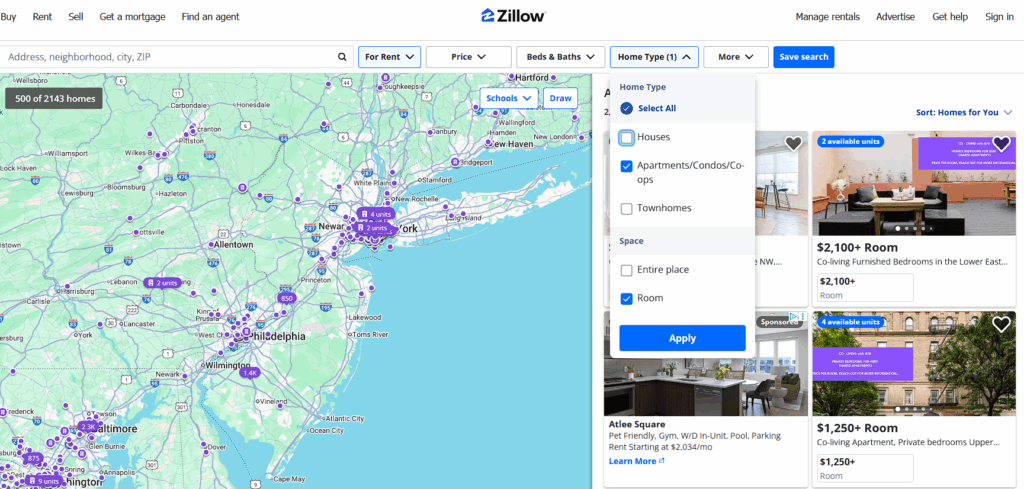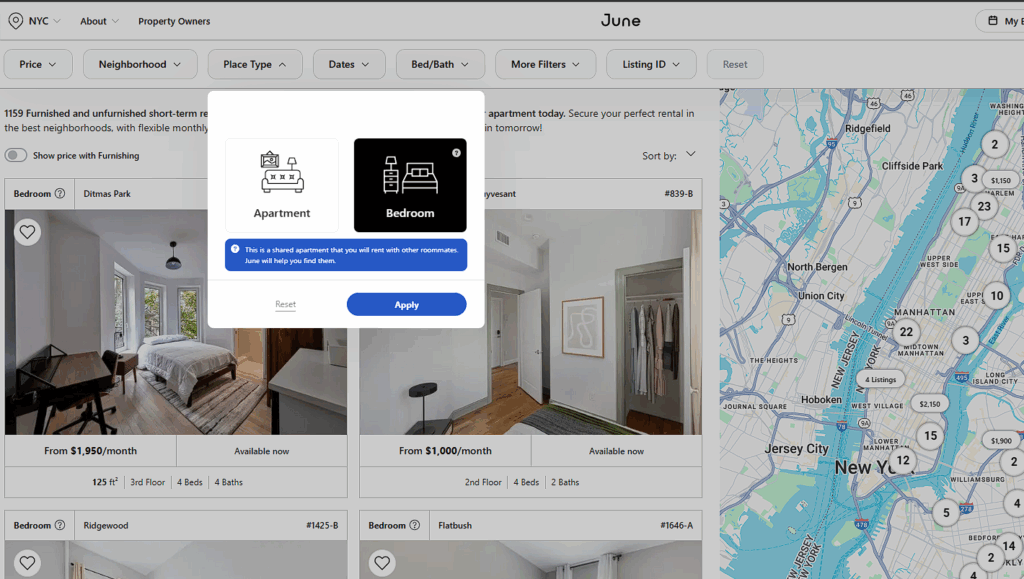Estimated reading time: 19 minutes

Welcome to the U.S. Rental Hunt!
Moving to a new country is exciting, but finding a place to live? That can feel overwhelming. If you’re searching for rooms for rent in the USA, you’re probably discovering that the American housing market has its own rules, vocabulary, and quirks. Between navigating unfamiliar lease terms, comparing prices across cities, and avoiding rental scams online, it’s easy to feel lost before you even arrive.
This guide will walk you through everything you need to know: where to look for rooms, what to expect in different cities, how U.S. renting actually works, and how to protect yourself throughout the process. Think of this as your crash course in finding a room that fits your new life in America.
How Renting a Room in the U.S. Works (and Where to Look)
Before you start your search, it helps to understand the main ways people find rooms for rent in the USA. Each option has its advantages and considerations.
Online Listing Platforms
Sites like Apartments, Spareroom, Zillow, Craigslist, and Facebook Marketplace are popular for finding local rental options. These platforms offer a wide variety of listings, from single rooms in shared houses to studio apartments. The challenge? Quality and reliability can be inconsistent. You might find great deals, but you’ll also encounter outdated listings, unresponsive landlords, and unfortunately, rental scams. If you use these platforms, always verify listings carefully and never send money before seeing the property or signing a legitimate lease.

Student Housing Platforms and Co-Living Companies
Many universities offer international student housing resources, and specialized co-living companies cater specifically to young professionals and students. These options tend to be safer and more newcomer-friendly, with furnished rooms and community features built in. The trade-off is that they can be pricier than traditional rentals and may have limited availability or strict lease requirements.
Verified Housing Platforms
Modern rental platforms have emerged to solve many of the pain points newcomers face. June Homes, for example, provides ready-to-move-in furnished rooms with flexible lease terms, transparent pricing, and verified listings across multiple U.S. cities. For someone moving from another country, this approach removes much of the guesswork.

15 Best Verified Platforms for Finding Rooms in the USA
1. June Homes – Offers fully furnished private rooms and shared apartments across major U.S. cities including New York, Boston, Chicago, Washington D.C., Los Angeles, San Francisco, and Austin. Flexible lease terms (1-18 months), no broker fees, and verified properties. Ideal for international students, interns, and young professionals who want a hassle-free move-in experience. Perfect for those who need travel nurse housing or temporary professional accommodations.
2. Zillow – One of the largest rental platforms in the U.S., Zillow provides comprehensive listings for apartments, rooms, and houses nationwide. While not exclusively for furnished or short-term rentals, it offers robust search filters, 3D virtual tours, and verified landlord reviews. Best for those comfortable navigating traditional rental searches and who plan to stay longer term.
3. Apartments.com – A major rental search engine with extensive listings across all 50 states. The platform includes detailed property photos, floor plans, amenities lists, and direct contact information for property managers. Offers a “verified source” badge for trustworthy listings. Good for comparing options across neighborhoods, though most listings are unfurnished and require standard lease agreements.
4. SpareRoom – Originally from the UK, SpareRoom has expanded to major U.S. cities and specializes in connecting people looking for rooms with those who have rooms available. The platform emphasizes compatibility matching through detailed profiles and offers both short-term and long-term options. Particularly useful for finding compatible roommate situations with verified user identities.
5. Roomster – A global roommate and room finding platform available in cities nationwide. Users can search for rooms, roommates, or list their own space. The platform includes verification features, background checks, and secure messaging tools to connect before committing. Better suited for those comfortable arranging their own viewing and lease terms.
6. Sublet.com – Focuses specifically on sublets, temporary housing, and furnished apartments, making it ideal for short-term stays (1-6 months). The platform is particularly popular with students, interns, and professionals on temporary assignments or summer programs.
For NYC-specific sublets, SubletSpots offers additional local options with verified landlords.
7. Common – A co-living platform offering fully furnished private rooms in shared homes across several U.S. cities including New York, San Francisco, Seattle, and Washington D.C. Common handles all utilities, WiFi, weekly cleaning services, and hosts community events. Leases are flexible month-to-month, and the model emphasizes community living with vetted housemates. Higher price point but includes many conveniences.
8. HousingAnywhere – Designed specifically for international students and young professionals, this European-based platform specializes in verified mid-term rentals (1-12 months) with secure booking and payment protection. Properties are often furnished, landlords are vetted, and payments are held in escrow until move-in. Particularly strong in university cities and offers 24/7 multilingual support.
9. Corporate Housing by Owner (CHBO) – Targets business travelers and relocating professionals with fully furnished apartments available for 30+ days. Properties tend to be upscale with full kitchens, linens, and amenities included. Pricing is higher but includes everything needed for a comfortable temporary stay. Ideal for work relocations or extended business trips.
10. Rent.com – A comprehensive apartment search platform with verified listings nationwide. Offers cash-back rewards for renters who find apartments through their service, plus professional guides and neighborhood insights. The platform partners directly with property management companies for accurate, up-to-date listings. Good mix of furnished and unfurnished options.
11. PadMapper – Aggregates listings from multiple sources including Craigslist, Zillow, and Apartments.com onto an interactive map interface. This makes it easy to visualize housing options by neighborhood and commute time. While it doesn’t host listings directly, it’s excellent for getting a comprehensive view of what’s available in your target area.
12. Roomi – A mobile-first roommate finding app that uses a swipe interface similar to dating apps. Users create profiles, and the platform uses an algorithm to suggest compatible matches. Includes identity verification, secure messaging, and integrated lease signing. Popular among millennials and Gen Z renters in major cities.
13. Airbnb – While primarily known for vacation rentals, Airbnb has a growing selection of monthly rentals at discounted rates. This can be an excellent option for your first month in the U.S. while you search for permanent housing. All hosts are reviewed, properties are photographed, and bookings are protected. Some hosts offer flexible long-term arrangements.
14. Furnished Finder – Specializes in housing for travel nurses, medical professionals, and traveling workers. Properties are fully furnished with flexible lease terms ranging from weeks to months. Landlords on this platform understand the unique needs of healthcare travelers and often offer amenities like parking and WiFi included.
15. Facebook Marketplace & Local Housing Groups – While not a dedicated platform, Facebook has become one of the most popular places to find rooms, especially in university towns and major cities. Join local housing groups (search “[City Name] Housing,” “[University Name] Off-Campus Housing,” or “[City Name] Rooms for Rent”) to find peer-to-peer listings. Many international student communities also have country-specific housing groups. Exercise caution: always verify listings in person or via video call before sending money, meet in public places, and never wire funds to unverified sources.
What Makes a Platform “Verified” and Trustworthy?
When evaluating rental platforms, look for these signs of legitimacy and security:
Property verification – Photos match reality, addresses are real and specific (not just “near downtown”), and listings are regularly updated with current availability. Legitimate platforms remove outdated or fake listings promptly.
Secure payment systems – Professional platforms use secure, traceable payment methods. Red flags include requests to wire money via Western Union, pay with gift cards, send cash, or use cryptocurrency. Legitimate platforms offer payment protection and escrow services.
Transparent pricing – All costs (rent, fees, deposits, utilities) are clearly stated upfront with no hidden charges. You should know the exact monthly cost before signing anything.
Landlord and tenant reviews – Both parties can leave verified feedback to build accountability and trust. Look for platforms where reviews can’t be easily deleted or manipulated.
Responsive customer support – Legitimate platforms have accessible help teams that can address concerns, mediate disputes, or answer questions. Look for phone numbers, live chat, or email support that actually responds.
Clear lease terms – Standard rental agreements that protect both parties’ rights, outline responsibilities, and explain move-in/move-out procedures. Avoid platforms or landlords who refuse to provide written agreements.
Background and identity checks – Many platforms now screen both landlords and tenants for safety. This might include ID verification, income checks, or criminal background screening.
Physical office or established presence – Trustworthy platforms have been operating for years, have physical business addresses, and are registered companies. Be wary of brand-new sites with no track record or social proof.
Choosing the Right Platform for Your Needs
Different platforms serve different needs. Here’s how to match your situation with the best option:
If you’re an international student or intern: June Homes, HousingAnywhere, or university-affiliated housing platforms offer the most support and understanding of visa requirements and international payment methods.
If you need housing immediately: June Homes, Airbnb monthly rentals, or furnished short-term options let you move in within days rather than weeks.
If you’re on a tight budget: Facebook groups, Roomster, and SpareRoom often have the most affordable peer-to-peer options, though they require more vetting on your part.
If you’re a travel nurse or medical professional: Furnished Finder and June Homes specialize in the flexible, furnished options healthcare travelers need.
If you want community and social connection: Common, SpareRoom, and Roomi emphasize compatible roommate matching and community building.
If you’re relocating for work: Corporate Housing by Owner, June Homes, and Airbnb long-term rentals provide professional, furnished solutions for temporary or permanent relocations.
Key Terms to Know
If you’re new to renting in America, here are some common terms you’ll encounter:
Security deposit: An upfront payment (typically one month’s rent) that landlords hold as insurance against damage or unpaid rent. You should get this back when you move out, assuming the room is in good condition. Learn more about security deposits.
Lease length: Rental agreements in the U.S. typically range from month-to-month to 12-month commitments. Shorter leases offer flexibility but may cost more per month. Longer leases usually lock in lower rates but require you to stay (or continue paying) for the full term.
Utilities included: This means your rent covers electricity, water, gas, and sometimes internet. If utilities are not included, you’ll need to set up and pay for these services separately, which can add $50-150+ to your monthly costs.
Broker fee: In some cities (particularly New York and Boston), you may need to pay a real estate broker 10-15% of the annual rent just to help you find an apartment. Many modern platforms eliminate this fee entirely.
Understanding these basics will help you compare options more confidently and avoid unexpected costs.
The Best Cities to Find Rooms for Rent in the U.S.
The United States is huge, and rental markets vary dramatically from city to city. Here’s what you need to know about finding rooms for rent in some of the most popular destinations for newcomers.
Rooms for Rent in New York City

New York City is where many international dreams begin, but the housing market here is notoriously competitive. Shared apartments are the norm, especially in Brooklyn and Queens, where rents are more manageable than Manhattan. A private room in a shared apartment typically ranges from $1,000 to $1,800 per month, depending on the neighborhood and amenities.
Popular areas for students and young professionals include Bushwick, Williamsburg, Astoria, and parts of Harlem. These neighborhoods offer good access to public transportation, diverse communities, and a vibrant mix of cafes, restaurants, and cultural spaces. Many newcomers choose furnished rooms to avoid the hassle (and expense) of moving furniture across boroughs. June Homes has excellent options throughout these areas, making it easier to settle in quickly.
Fun fact: New Yorkers rarely own cars. The subway system connects all five boroughs, so living near a train station is more valuable than having parking. Learn more about finding rooms in NYC.
Rooms for Rent in Boston

Boston is a university city through and through, with over 50 colleges in the metro area. This means there’s a well-established market for student housing and rooms for rent. Expect to pay between $900 and $1,500 per month for a private room in neighborhoods like Allston, Brighton, Cambridge, and Somerville.
The rental market here moves fast, especially before the fall semester when students flood the city. Boston also has a quirky tradition: most leases start on September 1st, creating an annual moving frenzy. If you’re arriving outside this cycle, you might find better deals and more availability.
The city is compact and walkable, with excellent public transit (the “T”). Living near a transit line opens up the entire city for work, school, and exploring historic sites. Find private rooms in Boston or read our complete guide to finding rooms in Boston.
Rooms for Rent in Washington, D.C.

The nation’s capital attracts interns, young professionals, and international workers in government, policy, and nonprofit sectors. Rooms for rent in Washington, D.C. typically range from $800 to $1,400 per month, with popular neighborhoods including Adams Morgan, Columbia Heights, Capitol Hill, and Arlington (just across the river in Virginia).
Many renters choose to live slightly outside the main downtown area where housing is more affordable, then commute via Metro, the city’s clean and efficient subway system. D.C. has a younger, transient population, so short-term and furnished rentals are common and well-suited to people arriving for internships or fixed-term positions.
The city offers an incredible mix of free museums, monuments, and cultural events, plus four distinct seasons (including hot, humid summers and occasional winter snow). Browse rooms for rent in Washington, D.C.
Rooms for Rent in Chicago

Chicago offers big-city energy with more affordable housing than coastal cities. Rooms for rent in Chicago typically cost between $600 and $1,100 per month, depending on the neighborhood. Popular areas for young professionals and students include Wicker Park, Logan Square, Lakeview, and Hyde Park (home to the University of Chicago).
Chicago is known for its strong neighborhood identities. Each area has its own character, from artsy and bohemian to family-oriented and quiet. The “L” train system connects most of the city, though winters can be brutally cold, so proximity to indoor train stations is a real advantage.
The lower cost of living compared to New York or San Francisco makes Chicago an attractive option for people starting careers or studying without breaking the bank. Explore rooms for rent in Chicago or learn how to find roommates in Chicago.
Rooms for Rent in Los Angeles
Los Angeles is sprawling, sunny, and car-dependent. Unlike most major U.S. cities, public transit here is limited, so most residents drive. Rooms for rent in Los Angeles range widely, from $800 to $1,600+ per month depending on location. Popular neighborhoods for newcomers include Koreatown, West Los Angeles, Culver City, and neighborhoods near USC or UCLA.
Because L.A. is so spread out, where you live matters enormously for your daily commute. Choose housing close to your school or workplace if possible, as traffic can easily turn a 10-mile drive into an hour-long ordeal.
The climate is famously perfect year-round, and the city offers incredible diversity, beaches, hiking, and entertainment industry opportunities. Just be prepared to budget for a car or rideshares if you’re not living in a particularly walkable area. Find rooms for rent in Los Angeles.
Rooms for Rent in San Francisco
San Francisco and the surrounding Bay Area have some of the highest rents in the country, driven by the tech industry. Rooms for rent in San Francisco typically start around $1,200 and can exceed $2,000 per month, even in shared apartments. Many newcomers also look at nearby cities like Oakland, Berkeley, or Daly City for more affordable options.
Popular neighborhoods include the Mission District, Sunset District, and areas near BART (Bay Area Rapid Transit) stations. The city is hilly, foggy, and surprisingly small, with distinct microclimates from neighborhood to neighborhood.
Despite the cost, San Francisco attracts people from around the world for opportunities in technology, innovation, and entrepreneurship. If you’re moving here, a furnished room with flexible lease terms can help you test out different neighborhoods before committing long-term.
Rooms for Rent in Miami
Miami offers a completely different experience: tropical weather, Latin American cultural influences, and a growing tech and startup scene. Rooms for rent in Miami generally range from $700 to $1,300 per month, with popular areas including Brickell, Coral Gables, Wynwood, and Little Havana.
Unlike many U.S. cities, Miami is very car-oriented, though some neighborhoods are becoming more walkable and bike-friendly. The city has no state income tax, which helps offset living costs for working professionals.
Miami’s appeal lies in its year-round warmth, beaches, nightlife, and bilingual environment where Spanish is widely spoken. It’s particularly welcoming for international residents from Latin America and the Caribbean.
Rooms for Rent in Austin
Austin has boomed in recent years as a tech hub, cultural center, and college town (home to the University of Texas). Rooms for rent in Austin typically cost between $700 and $1,200 per month. Popular neighborhoods for students and young professionals include East Austin, South Congress, Hyde Park, and areas near the university.
The city is known for its live music scene, food trucks, outdoor activities, and laid-back atmosphere. Like most of Texas, Austin is car-friendly, though the city is investing heavily in public transit and bike infrastructure.
Housing prices have risen as more people move to Austin, but it remains more affordable than coastal cities while offering a vibrant, creative community and warm weather nearly year-round. Browse rooms for rent in Austin or explore the best neighborhoods in Austin.
Why Flexible, Furnished Rentals Are Changing the Game
The way people live and work has changed dramatically in recent years. Remote work, shorter job assignments, international mobility, and flexible lifestyles have created new demands in the rental market. For many newcomers to the USA, the traditional model of signing a year-long lease, buying furniture, setting up utilities, and committing to a neighborhood you don’t know yet simply doesn’t fit.
This is why flexible, furnished rentals have become so popular. They’re designed for how people actually live today: moving between cities for opportunities, testing out neighborhoods before settling in, working remotely while traveling, or coming to the U.S. for a semester or internship without wanting to commit to a full year.
Platforms like June Homes or Blueground specialize in this model. Instead of spending weeks apartment hunting, coordinating furniture delivery, and setting up utility accounts in a country where you might not even have a credit history yet, you can move into a fully furnished room with utilities included. Lease terms are flexible, ranging from one month to a year, so you’re not locked into a commitment that doesn’t match your plans.
There are no broker fees, which in cities like New York and Boston can save you thousands of dollars upfront. The pricing is transparent and all-inclusive, so you know exactly what you’re paying each month without surprise bills. And because the apartments are verified and managed by a professional company, you avoid the risks of rental scams or unresponsive landlords that plague sites like Craigslist.
This approach isn’t just convenient; it’s practical. When you’re adjusting to a new country, dealing with time zones, maybe starting a demanding job or academic program, the last thing you need is housing stress. Furnished, flexible rentals let you focus on what matters: building your new life, exploring your city, and actually enjoying the experience of living in the USA.
Smart Tips Before You Rent a Room in the U.S.
Finding the right room is one thing. Making sure you’re protected and informed throughout the process is another. Here are practical tips every first-time renter in America should know:
Always confirm if utilities are included in the rent. Electricity, water, gas, and internet can add $50-150+ to your monthly expenses if they’re not included. Make sure you understand exactly what your rent covers before signing anything.
Request a virtual tour if you can’t visit in person. Most landlords and modern platforms now offer video tours or live virtual walkthroughs. This is especially important if you’re moving from abroad and can’t easily fly in to see apartments yourself.
Read the lease carefully and understand move-in and move-out terms. Pay attention to how much notice you need to give before leaving, what happens if you break the lease early, and whether your security deposit is refundable. If anything is unclear, ask questions before signing.
Never send money before signing a lease or verifying the listing. Rental scams are common, especially on sites like Craigslist and Facebook. Legitimate landlords and platforms will not ask you to wire money, pay through untraceable methods, or send deposits before you’ve signed proper documentation.
Consider furnished housing to save time and setup costs. Moving to a new country with furniture is impractical and expensive. Even buying furniture locally takes time and money. Furnished rooms let you move in immediately with everything you need, which is invaluable when you’re starting fresh.
Think about transportation and location. In most U.S. cities outside New York, San Francisco, and Chicago, you’ll likely need a car or rely on rideshares. Living farther from work or school might save money on rent but cost more in time and transportation. Calculate the full picture before choosing based on rent alone.
Check reviews and ask for references. If you’re renting through a platform or landlord you’re unfamiliar with, look for reviews from previous tenants. Trustworthy platforms will have transparent feedback and professional customer service.
Understand your rights as a tenant. Tenant laws vary by state, but you generally have rights regarding habitability, privacy, and security deposit returns. Familiarize yourself with basic protections so you know what’s reasonable to expect from your landlord.
Be prepared with necessary documents. Landlords typically ask for proof of income, identification, and sometimes references. International renters may need additional documentation like visa status or a letter from an employer or university. Having these ready speeds up the application process. If you’re renting in the U.S. as a foreigner, this guide can help.
Trust your instincts. If something feels off about a listing, a landlord’s communication, or the condition of a property, don’t ignore that feeling. There are plenty of legitimate options available; you don’t need to settle for something that makes you uncomfortable.
Find a Room That Fits Your New Life
Renting in a new country can feel daunting, especially when you’re navigating unfamiliar systems, vocabulary, and expectations. But with the right information and reliable resources, finding a room doesn’t have to be stressful or overwhelming. Thousands of people move to the United States every year and successfully find comfortable, safe housing that fits their needs and budgets.
The key is knowing where to look, understanding what questions to ask, and choosing platforms and landlords you can trust. Whether you’re drawn to the energy of New York City, the academic atmosphere of Boston, the policy world of Washington D.C., or the sunshine of Los Angeles and Miami, there’s a community waiting for you and a room that feels like home.
Whether you’re moving for a semester, a new job, or just a change of pace, finding a safe, flexible room doesn’t have to be stressful. With verified listings and fully furnished options from June Homes, you can focus on settling into your new city, exploring your neighborhood, meeting new people, and actually living your life, not worrying about where to sleep.
Welcome to the USA. Now go find your room and start your adventure 😉